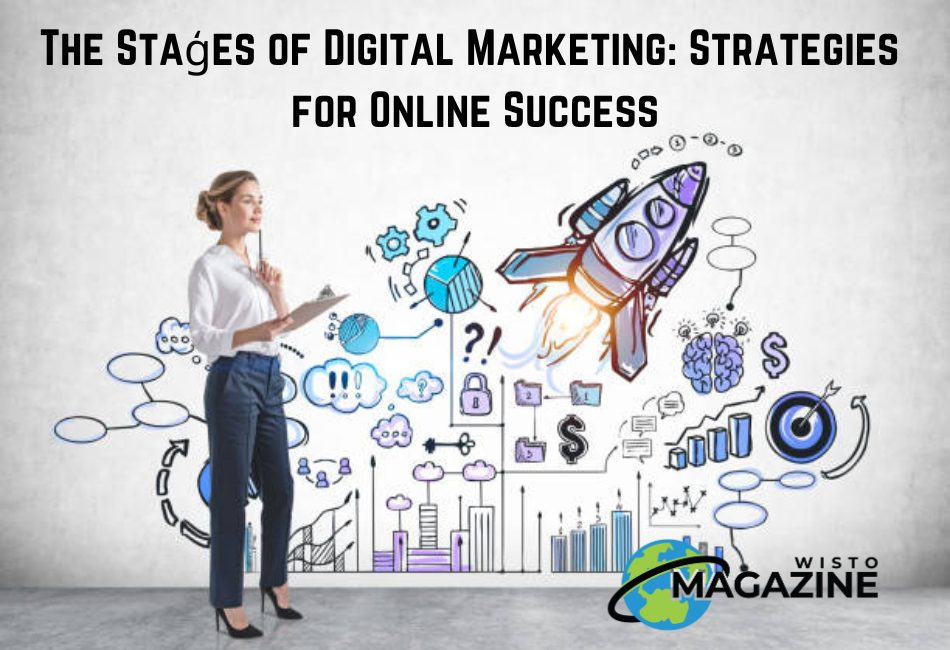In today’s fast-paced digital landscape, mastering the art of digital marketing is crucial for any business aiming for online success. With the right strategies, you can effectively reach and engage your target audience, drive traffic, and convert leads into loyal customers. This comprehensive guide will walk you through the essential Staģes of digital marketing, providing actionable insights and strategies for each step of the journey.
1. Market Research and Analysis Staģes

The foundation of any successful digital marketing campaign is thorough market research and analysis. Understanding your target audience’s needs, preferences, and behaviors is essential for crafting effective marketing messages and strategies.
Conducting Market Research
Start by identifying your ideal customer profile. Use tools like surveys, focus groups, and social media listening to gather data on your audience’s demographics, interests, and pain points. Analyze your competitors to understand their strengths and weaknesses and identify market gaps you can exploit.
Utilizing Analytics Tools
Leverage analytics tools such as Google Analytics, SEMrush, and Ahrefs to gain insights into market trends, keyword performance, and audience behavior. These tools can help you make data-driven decisions and refine your marketing strategies.
2. Defining Goals and Objectives
Setting clear and achievable goals is crucial for measuring the success of your digital marketing efforts. Your goals should be SMART: Specific, Measurable, Achievable, Relevant, and Time-bound.
Aligning Goals with Business Objectives
Ensure that your digital marketing goals align with your overall business objectives. Whether you aim to increase brand awareness, generate leads, or boost sales, your goals should support your long-term business vision.
Examples of Digital Marketing Goals
- Increase website traffic by 30% in the next six months.
- Generate 500 new leads per month through content marketing.
- Boost online sales by 20% in the next quarter.
3. Building a Strong Online Presence

A strong online presence is the cornerstone of digital marketing success. Your website and social media profiles should reflect your brand’s identity and provide a seamless user experience.
Developing a User-Friendly Website
Your website is often the first point of contact between your brand and potential customers. Ensure it is mobile-friendly, easy to navigate, and optimized for search engines. High-quality content, fast loading times, and clear calls-to-action (CTAs) are essential for keeping visitors engaged and encouraging conversions.
SEO Best Practices
Implementing SEO best practices is crucial for improving your website’s visibility in search engine results. Focus on keyword optimization, quality backlinks, and on-page SEO elements such as meta tags, headers, and alt text for images. Regularly update your content to keep it fresh and relevant.
Optimizing Social Media Profiles
Choose social media platforms that align with your target audience’s preferences. Ensure your profiles are complete, with consistent branding, and actively engage with your followers. Use social media to share valuable content, respond to inquiries, and build a community around your brand.
4. Content Creation and Marketing

Content is king in digital marketing. Creating high-quality, relevant, and engaging content is essential for attracting and retaining your audience.
Developing a Content Strategy
Your content strategy should be based on your target audience’s needs and preferences. Identify key topics and formats that resonate with your audience, such as blog posts, videos, infographics, and podcasts. Plan a content calendar to ensure a consistent flow of fresh content.
Creating Engaging Content
Focus on creating content that educates, entertains, or inspires your audience. Use storytelling techniques to make your content more relatable and memorable. High-quality visuals and compelling headlines can also enhance your content’s appeal.
Content Distribution and Promotion
Sharing your content across various channels is crucial for maximizing its reach. Use social media, email marketing, and guest blogging to promote your content. Collaborate with influencers and industry experts to expand your audience and increase credibility.
5. Social Media Marketing

Social media marketing is a powerful tool for building brand awareness, engaging with your audience, and driving traffic to your website.
Choosing the Right Platforms
Identify the social media platforms that are most popular with your target audience. Focus your efforts on a few key platforms rather than spreading yourself too thin across multiple channels.
Developing a Social Media Strategy
Create a social media strategy that outlines your goals, target audience, content plan, and posting schedule. Use a mix of organic and paid tactics to maximize your reach and engagement.
Engaging with Your Audience
Actively engage with your followers by responding to comments, messages, and mentions. Use social media to start conversations, ask questions, and gather feedback. Building a strong community around your brand can lead to increased loyalty and advocacy.
6. Email Marketing
Email marketing remains one of the most effective ways to nurture leads and convert them into customers.
Building and Segmenting Your Email List
Start by building an email list of interested subscribers. Use lead magnets such as free eBooks, webinars, or discounts to encourage sign-ups. Segment your list based on demographics, behavior, and preferences to deliver more personalized and relevant content.
Creating Effective Email Campaigns
Craft compelling email campaigns that provide value to your subscribers. Use attention-grabbing subject lines, clear CTAs, and engaging content to drive action. Personalization and automation can enhance the effectiveness of your email marketing efforts.
Measuring Email Marketing Performance
Track key metrics such as open rates, click-through rates, and conversion rates to measure the success of your email campaigns. Use A/B testing to optimize your emails and improve performance over time.
7. Pay-Per-Click (PPC) Advertising

PPC advertising is an effective way to drive targeted traffic to your website and generate leads quickly.
Overview of PPC Advertising
PPC advertising involves bidding on keywords to display ads on search engines or social media platforms. You pay a fee each time someone clicks on your ad, making it a cost-effective way to reach potential customers.
Setting Up and Managing PPC Campaigns
Start by conducting keyword research to identify high-value keywords relevant to your business. Create compelling ad copy and design eye-catching visuals to attract clicks. Set a budget and monitor your campaigns regularly to optimize performance.
Analyzing and Optimizing PPC Campaigns
Use analytics tools to track the performance of your PPC campaigns. Monitor key metrics such as click-through rates, conversion rates, and return on ad spend (ROAS). Adjust your bidding strategy, keywords, and ad creatives based on your findings to improve results.
8. Analytics and Performance Measurement
Measuring the effectiveness of your digital marketing efforts is crucial for continuous improvement and success.
Importance of Tracking and Analyzing Metrics
Regularly tracking and analyzing your digital marketing metrics allows you to identify what’s working and what needs improvement. It also helps you make data-driven decisions and optimize your strategies for better results.
Key Performance Indicators (KPIs) to Monitor
Identify the KPIs that are most relevant to your goals, such as website traffic, conversion rates, customer acquisition cost, and lifetime value. Use these metrics to evaluate the success of your campaigns and make informed adjustments.
Using Data to Refine Strategies
Use the insights gained from your analytics to refine and improve your digital marketing strategies. Experiment with different tactics, test new ideas and stay adaptable to changing market trends and consumer behaviors.
Conclusion
Mastering the Staģes of digital marketing is essential for achieving online success in today’s competitive landscape. By conducting thorough market research, setting clear goals, building a strong online presence, creating engaging content, leveraging social media, utilizing email marketing, implementing PPC advertising, and continuously measuring performance, you can develop effective strategies that drive results.
Remember, digital marketing is an ongoing process that requires continuous learning and adaptation. Stay updated with the latest trends and technologies, and be willing to experiment and innovate. With dedication and the right strategies, you can achieve online success and take your business to new heights.

